Honeysuckle Notes
Honeysuckle in Woodcock cover? I don't call the DNR.
I dial "Popple 911"NOTE: Please get any needed agreements approved by local DNR or private property owners BEFORE purging Honeysuckle from the face of the earth... The local magistrate MAY be amused if you claim "hot pursuit" as a justification. Chances are it won't get the charges dropped...
Woodcock Notes
20231031 Thoughts
Still getting in cuts, started in February, things got pretty unpleasant about the second week of June, then I started making mobility cuts in August. Tough year for Woodcock in South Central Wisconsin. Started out normally, then got hot and dry in late June and stayed that way into September.
Gradations of Hate
To me, clearing Honeysuckle and Glossy Buckthorn involves a few factors, presence of successors and existing cover. If these invasives have infiltrated existing cover [ex. Dogwoods, Plums, Popples...] then by all means purge with righteous fury. The existing cover will be released and will take advantage of the lack of competition next spring.
Some locations may lack much desirable cover, and there isn't any apparent successors. I have left clumps of open habit Honeysuckle to provide vertical cover while the existing cover re-establishes itself. Glossy Buckthorn is not desirable, -BUT- it has a growth habit resembling Popple, somewhat open with single trunks. It will eventually need to be cut, but it has a softer wood than Common Buckthorn and does not have multiple trunks twisted together.
Common Buckthorn should be cut anywhere. The branches are NOT open and Woodcock can't clear it as easily. While other trees and shrubs are dropping leaves, the Common Buckthorn is still a Green Wall of Damnation. The Common Buckthorn can grow into a single trunk up to 5" across, or it can take a multi-trunked form where the individual trunks are intertwined. Wood is pretty hard as well.
I have recently seen an old Apple tree with some deep red, glossy apples, and it was surrounded with Glossy Buckthorn. The ground was open and -resembled- a stand of Popples [but they're NOT!]. Pushed a Woodcock out of it.
There is a small clump of Popples, with the classic open ground, covered with Popple leaves. But there are Glossy Buckthorn saplings in there. Existing desirable cover does not need any help from Glossy Buckthorn.
NOTE: [Web] original location, [Web Only] the item is in HTML on the Web.
NOTE: I am not an organic chemist, toxicologist, or a biologist. These are just my opinions. Although I have watched Marlon Perkins hosting Mutual of Omaha's "Wild Kingdom". Just like sleeping at Holiday Inn...
Why Your Glyphosate May Not Be Working Mineral content [hardness] and turbidity.
Glyphosate - Human Health and Ecological Risk Assessment In short - don't drink it.
Impact of Honeysuckle (L. maackii) Leachate on Culex pipiens Life History Attributes
The Impact of Water Quality on Pesticide Performance Distilled water lacks calcium
Herbicide Treatments for Controlling Invasive Bush Honeysuckle in a Mature Hardwood Forest in West-central Indiana (Web)
The Prairie Enthusiasts
Prairie Bluff Chapter
Some Thoughts on Individual Tools and Techniques [Second SKIL RS5884 dies]
Current Reciprocating Saw Pruning Blade SAWZALL 48-00-1303
Japanese-Toothed or Tri-Toothed Pruning Blades No longer used! $$$
Injurious Effects of Bush Honeysuckle
Honeysuckle Control
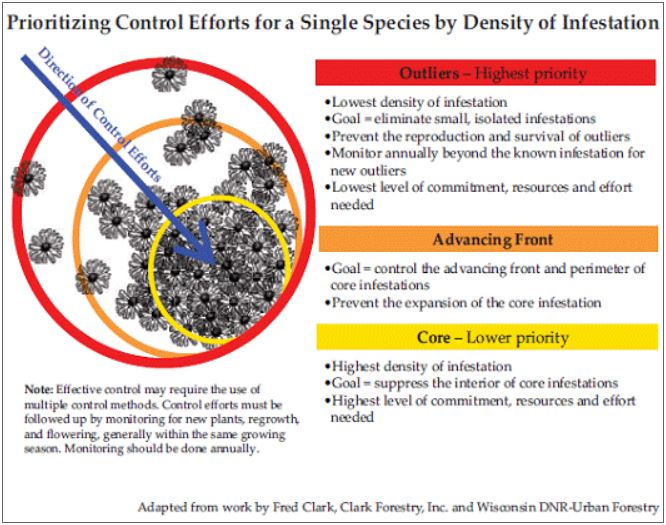
Honeysuckle 3-5 years old and older set fruit. The older Honeysuckle tend to have more viable fruit. When faced with a large area, prioritize control. At this time, it looks like
Cut: [Limit spread]
Big Honeysuckle near wetlands, slow moving, or stagnant water.
Isolated big Honeysuckle
Prioritizing within a Control Area
1. Focus on large blocks of un-invaded areas and keep them free of invaders
2. Control small, younger, outlier (satellite) populations first
3. “Unfragment” the boundaries of invaded areas by removing outlying plants
4. Reverse the invasion, expand the un-invaded area outward
It is crucial to prioritize control by determining where the satellite populations are, and eradicating those before they join up with larger populations.
Some Thoughts on Individual Tools and Techniques
Present Loadout 24 DEC 2022
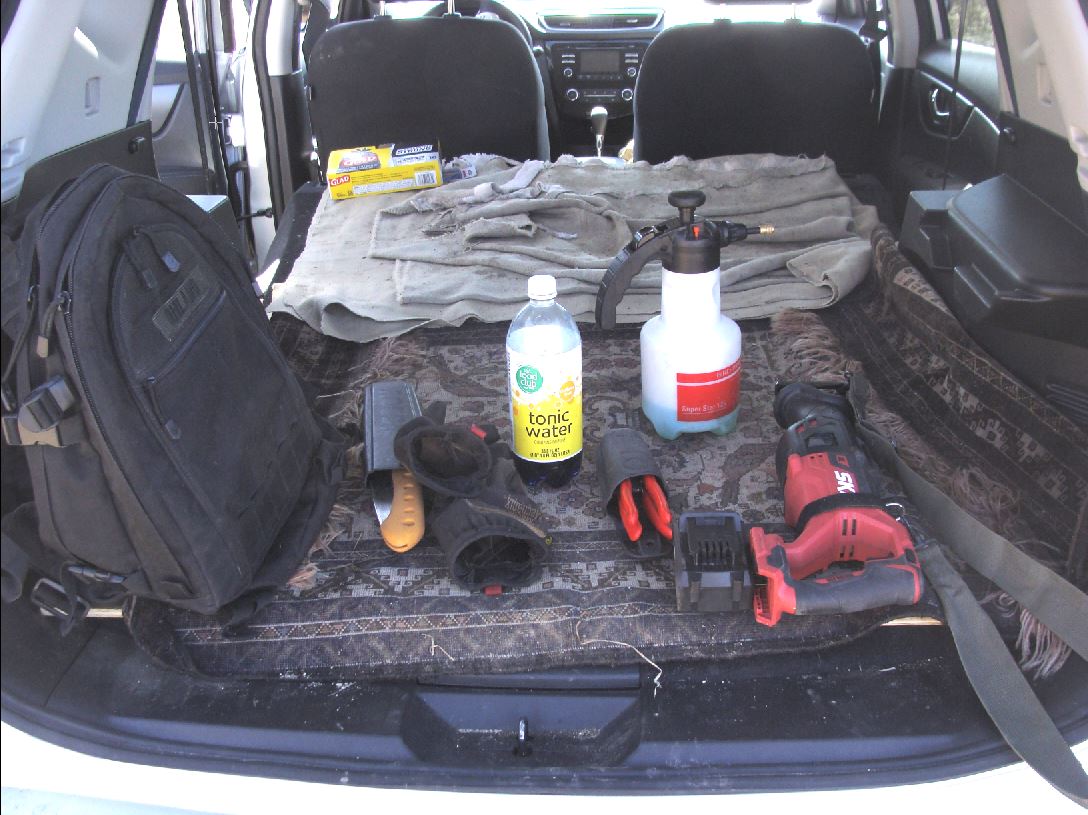
This is my current loadout. Backpack, gloves, Felco #2 hand pruner and 8" Kniphex "CoBolt" small bolt cutter (left in car), Birchmeier Super Spray 1.25 hand sprayer with 25% Glyphosate, 20v 4Ah battery [other in backpack], and a Skil PwrCore 20v reciprocating saw. Not shown: eye pro, blades, camera.
I no longer use a holster for the Felco, there is a slash pocket on my Riggs Jeans. You just have to keep checking for them before leaving a cut. They usually stay in the pocket if you put them in "point first". Don't use "handles first", the weight is outside of the pocket...
Switched over to distilled water and I no longer need to mix at the cut site. Quit using the sling, I just carry it over one shoulder. The Silky Bigboy is left in the car as back-up. Though the idea of extended cutting with it makes me twinge.
Mix Glyphosate with Distilled Water
Distilled water lacks the calcium, manganese, and iron that Glyphosate LOVES to bond with. It also has a pH of 7.0, another characteristic that maintains the efficacy of Glyphosate.
Storage: Store above 5°F (-15°C) to keep product from crystallizing. Crystals will settle to the bottom. If allowed to crystallize, place in a warm room 68°F (20°C) for several days to redissolve and roll or shake container to mix well before using.
NOTE: I had 53.8% concentrate on my unheated porch in temperatures down to -10°F, and yes, it DOES crystallize. Temperatures are swinging back up to the 60s during the day, but there is still a crystallized Glyphosate "ring" near the bottom. When you shake the jug, it sounds "slushy". I have not found any specific information, but I wonder if freezing separates the Glyphosate salt from the inert ingredients...
All the studies and papers do not mention the longevity of a Glyphosate / distilled water mix. From my personal experience, a mix will stay effective for MONTHS.
Useage of Mix
It depends. My rule of thumb is to have about 20oz (0.5L) in the sprayer. I cut alone, so that might be a bit short if you have a cutting team at work.
Neutralizing Glyphosate
From reading the various documents on Glyphosate, it gives me the impression that it darn well binds enthusiastically with soil. Look at the half life of Glyphosate, depending on the water composition, we could be talking about hours.... No wonder you see "mixing at the parking area".
So, what to do with cleaning up a Glyphosate concentrate spill? Perhaps agricultural limestone powder?
Get Tools Sufficient for the Job
Hand pruners for small stems [bypass]
Reciprocating saw [for old Honeysuckle or stands of Honeysuckle -OR- Buckthorn]
As Needed: Cutter Mattock [if you do a lot of root docking]
Folding saw - Backup / Scattered Honeysuckle [BigBoy 2000 XL]
Decent spray bottle [Birchmeier Super Star 1.25]
Decent gloves Mechanix Fastfit (good for Woodcock season!)
Eye protection [branches whipping around]
Glyphosate concentrate, Aquatic [used to make a @25% Glyphosate/Water mix]
Spray marker dye [you can see cut stumps easier]
I am still tweaking the tools I carry.
UPDATE: I saw a web page on "Root Docking". If you have seen a Honeysuckle where the junction of all the stems is in an above-ground knob, removing that knob [root collar] will kill it. The remaining roots will not regrow. Though I've not seen an actual article or paper yet.
Long-handled Cutter Mattock from Easydigging
Head - Belota (Spain), handle from South Africa. Haven't used it on Honeysuckle yet, the time I was going to use it, I found some smashed glass which had to be cleaned up.
UPDATE: Another simple tool is a narrow hoe with a long blade, like that of a mattock. Just chop into the dirt below the root collar and lever it up. Obviously, this is for mid-size Honeysuckle.
Hand Pruners
A bypass pruner works well on young Honeysuckle sprouts from 1/8 to 1/4 inch.
UPDATE: You won't find only vertical or horizontal stems, nor will you be able to be able to always get a clear approach. Sometimes, I found myself lacking leverage on bigger stems [1/2" and up] with my Felco F-2 hand pruners, usually due to bad approach angles.
Folding saw
For small patches or scattered specimens, a folding saw does nicely. I chose a Silky Pocketboy 170 with large teeth.
They cut on the pull stroke. I didn't have any issue with bending the blade. If you need to work a 4" trunk, you can use two hands and really pump it out. You might want a little bigger handle [Silky Gomboy 220] but the Pocketboy fits my hand pretty well.
Silky BIGBOY 2000, 360mm ( XL Teeth )
I moved up to the BigBoy XL, and it sure does a heckuva job. The longer handle makes a two-handed cut easy. After campaigning most of September-October 2020 with it, and having cast many servants of darkness down, it is a suitable weapon for pacifying small patches, say 20 yards in diameter. But...
Cordless Reciprocating Saw
After volunteering to clear Honeysuckle and Buckthorn infesting Woodcock habitat, my trusty BigBoy XL came up short. NOT that it failed to keep cutting, or bent, or rusted, but when you transition to a band of Glossy Buckthorn and scattered Honeysuckle probably 75 yards deep and a good 150 yards long, it's just not enough. Plus there are old growth Glossy Buckthorn a good 5" in diameter. And Honeysuckle just as old. If you can cut a big enough clearing to pile cut branches (Glossy Buckthorn reaches 15') then you don't have to re-cut them so they pile in a small enough pile...
UPDATE 020201120: I went out alone to face the teeming hordes of Honeysuckle and Buckthorn with my Skil RS5884 PWRCORE 20V reciprocating saw and two 4Ah batteries. The batteries lasted me for six hours, but plenty of slash hauling, seedling pulling, and herbicide painting also happened. With my trust ZETSAW (Z-Saw) PRUNING R-210 [No. 20103] blade, I cut down everything the blade touched.
The Japanese toothed pruning blade rarely grabs a small branch or hooks a trunk. I tried a Milwaukee Sawzall "Axe" blade that has 3 TPI [BIG gullets], and you had to start the saw, then start cutting, or the blade would "catch" and stall the saw.
You do have to use the shoe when working a trunk [gives you leverage] and when working a branch [keeps the branch from vibrating]. When cutting a Honeysuckle at ground level, the roots keep the saw from pulling and pushing the wood during the cut. The shoe comes in very useful with multiple stems, because they aren't fixed like the trunk.
The Zetsaw blade will smoke a little if you are cutting sappy wood. Just run it through some dry wood to clean it. With care, you should be able to handle up to 5" trunks, but you will have to cut branches in order to reduce the load. I pruned branches off, then cut on a diagonal so the upper trunk slides down. I may try notching then cutting down to it, like using a chainsaw, but with finesse. IMHO, any trees with significant branches up out of reach is past the reasonable use of a reciprocating saw. It might do it, but we are entering the domain of bucking standing trees...
Some thoughts - The reciprocating saw is heavy and lacks any sling points. They are designed for workzones, not quarter-mile hikes to get to the cut site. It seems quite logical to cruise the woods and identify the sites where you need the reciprocating saw, then backpack it in and kill them all... If you can use a UTV or ATV to reach the cut site, then this doesn't apply. Safety is still important. When cutting, keep body parts out of the blade's path. Thankfully, the reciprocating saw stops pretty fast, and I was wearing double thickness Wrangler's Carpenter's jeans... Enough said about that.
One ding on the Skil RS5884, the side lever that switches from straight line to oscillating cutting can be moved when you are holding the saw horizontal, cutting a trunk next to the ground. I have had this switch half-way between positions, and I could not feel anything different in the saw's function. My guess is that it has to be fully in one position to shift to that mode. It snaps firmly into position at each limit, but the spring or retention setup needs to be about twice as strong IMHO.
When cutting Honeysuckle or Buckthorn, I've NOT noticed any improvement with cutting speed or ease by using the oscillating position.
22 Apr 2021 - Skil RS5884 Dead
One moment, it was cutting great, put it down, moved some slash, picked it up for another cut, and NOTHING. No light, noise, heat, or movement. Swapped in fully charged battery, nada. Sent it in, but there are NO parts for it. Not "on the slow boat from Red China", but there are no parts for this older model. Bought it in October of 2020, so it was still under warranty.
Skil support is phone ONLY, no email. They do email you after every call to Skil Support, but the ticket changes for every call. You cannot email them any documents.
23 Sep 2021 - Another Dead Skil RS5884
You can't make this stuff up. Finally got the replacement for the first RS5884 on 10 June 2021. Weather was pretty hot or wet so I didn't do any Honeysuckle or Buckthorn cutting until late August, 2021. I made nine cuts, most only used half a 4Ah battery.
On 23 Sep, I dropped two very mature multi-trunked Common Buckthorn. Lopped off the branches and dragged them over to a burn pile maybe 50 yards away. I drained one 4Ah battery so it was barely moving the blade a few times, then swapped in a fully charged 4Ah, and it was right back to full performance. Barely used one bar [out of four], then staggered over to complete opening a path through a patch of Common Buckthorn. Drained the second one to one bar, then the saw died.
Mid Dec 2021 - Second Replacement RS5884 Arrived
Folks, do not try to be understanding, just ask for the complete kit, pull the new saw out, slap the dead saw into the box, then return it. I tried being understanding, but SKIL could not find someone to "strip" the kit and send only the saw. Eventually, I figured out the best is the enemy of the good, and I asked SKIL to send the kit, and I did the swap-out.
Recap of RS5884 in 2022 Cutting Season
Well, the third saw managed to get me through my April cutting, then August / September / November / December... Third time's a charm?
RS5884 in 2023 Season
Well, four cuts so far, killing everything I put screaming steel to.
Current Reciprocating Saw Pruning Blade
48-00-1303 SAWZALL 12 in. 5 TPI Pruning Blade @ $30 for a 5pk
12" cutting edge, Swiss Made, .062" thick. This resists bending, and any bends are usually slight. Most of the time, I can straighten out the bend with my gloved hands.
Japanese-Toothed or Tri-Toothed Pruning Blades
UPDATE: After snapping the tangs on two R-300 blades, I switched to Bosch RP125 blades, not as thrilling as the ZETSAW blades, but it is expensive to get the ZETSAW blades shipped from Japan. Pity. The RP125 blades DO take a bend, but the performance on smaller Honeysuckle is pretty good. The gullets don't seem to catch on the stems, so the saw won't stall.
Historical Pondering:
I have used other blades to cut invasive Bush Honeysuckle, and I started out with Zetsaw blades for a clean cut [better uptake of herbicide by Cambium layer], close teeth set [rarely snags on small stems], and extreme sharpness. So far, I have beat on an R-210 in a 20v reciprocating saw, and it holds up to it. It doesn't take a set if you pinch it or if the tip slams into a trunk past the one you're cutting.
Unfortunately, both the R-210 and R-300 blades do work in a 20v saw, but they can be snapped at the tang when horsing through a big branch...
ZETSAW (Z-Saw) PRUNING R-210 No. 20103 Shelter Tools 14.4v or LESS!

True, it is a straight blade, but it is scary sharp.
Blade Length : 210mm / 9"
Pitch : 3.00mm (8TPI)
Thickness : 0.90mm <-- 14.4V or less
ZETSAW FINE WOOD & PRUNING R-300 # 20110 Japan Agri Trading OVER 14.4v !
Blade Length : 300mm / 12"
Pitch : 3.50mm (7TPI)
Thickness : 1.20mm <--- Needed for saws OVER 14.4V

These blades have one [understandable] weakness. If you are cutting a heavy branch and it binds the saw blade in the kerf -AND- you are cutting at an angle, you might snap the blade right in front of the tang.
To be clear, the saw body is NOT at a right angle to the branch / trunk being cut. Then when the blade is pinched, the shaft tries to run forward [or pull back] and the direction between the saw blade and the saw body is not aligned any more. Puts too much cross stress on the tang and you get very pretty scrap on the forest floor...

Lost the image after my laptop crashed...
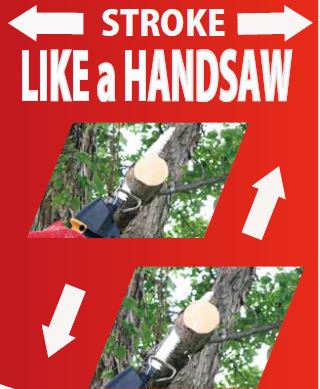
ZETSAW suggests using it like a handsaw, back and forth, that way the gullets are emptied.
Lee Valley Pruning Blade for Reciprocating Saws EC680

6.5 TPI Japanese tooth pattern, the 7" long blade.
SK11 by Fujiwara HERE

SK11 is a brand used by Fujiwara Sangyo Co. My thanks to Tatsuo Sunagawa for tracking down the [Japanese!] product page.
240mm -OAL:240mm, Edge: 210mm, Thickness: 0.5mm, -8 TPI
SRSB-001 -Edge: 160mm -OAL: 200mm -Thick: 0.6mm -Pitch: 3.0mm / 8.47 TPI
SRSB-002 -Edge: 240mm -OAL: 280mm -Thick: 0.9mm -Pitch: 3.0mm / 8.47 TPI
SRSB-003 -Edge: 240mm -OAL: 280mm -Thick: 0.9mm -Pitch: 3.0mm / 8.47 TPI
The SRSB 004/005/006 are also Tri-Toothed, but have a finer pitch, from 14-16 TPI.
AKKU-TOP Saw blades kwb Germany GmbH HERE

576200 8 TPI / 3mm pitch, OAL 230mm, cutting edge 190mm
Wood / Clean Cut Blade from Makita HERE

8.5 TPI, OAL 250mm, 1.0mm thick, high carbon steel
B-62016 single blade only
Shark Saw by Takagi HERE

Takagi Shark Saw Live Wood 230 mm Style:生木用
Thickness:0.9mm
OAL:230mm
Blade Length:210mm
Pitch:3.0mm / 8 TPI
Material:SK-85
Takagi Shark Saw Woodworking 230 mm Style:木工用
Thickness:0.9mm
OAL:230mm
Blade Length:210mm
Pitch:2.8mm
Material:SK-85
T-Rex Extreme Reciprocating Pruning Saw Blade

Honestly, t-rexextreme.com seems to disappeared by 2018, Heady Manufacturing Company doesn't seem to generate many hits. Search on-line and you will see a few YouTube videos, there should be some on Flea-Buy.
Fleam Ground Blades
I just used a Lenox 9 in. Bi-Metal Reciprocating Saw Blade 6 TPI 5 pk Ace Hardware Item no. 2472363 / Lenox 121029W6R. 1.3mm / .050 thick blade, 9" long. They take a bend.
Not as neat as the Zetsaw if it is a small stem, but when cutting larger stems near the ground, the cut quality is pretty good. It will take a bend if you let it. Also, a 5 pack for $21 plus tax, versus $20 to ship from Japan... And a two to three week wait...
Bosch "Edge" Pruning Blade [RP125]
Disappointed. It might be a mistaken perception on my part, but it seems to take more power to drive it -AND- it takes a bend. I tried it on a mature Buckthorn, smacked into a trunk on the other side, and the blade looked like a lazy "S".
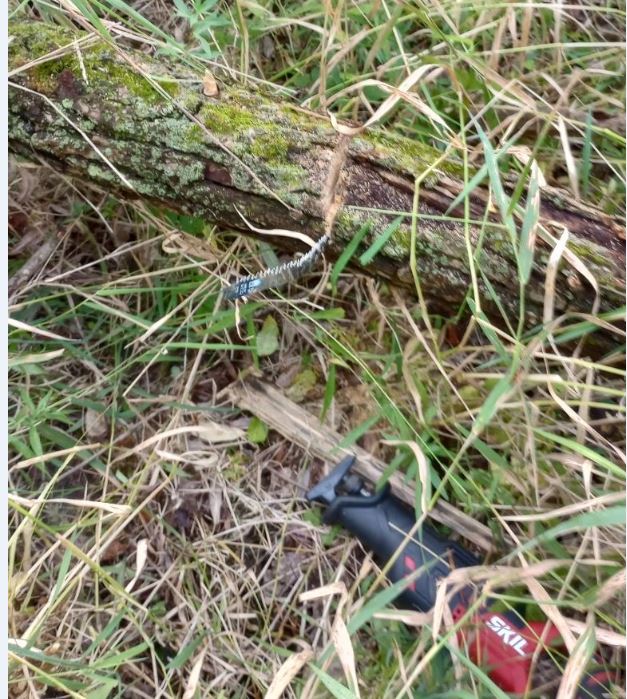
This is a pinched RP125 after trying to cut upward through a Willow branch hanging above a trail. The big bow was formed after the blade got pinched and the saw rammed the blade forwards.
Fencing Wire Cutters
For clearing on old farms, something to clean up remaining barbed wire OR electric fence wire. Diagonal cutters are not good. Something with a wire-cutting notch, like fencing pliers -OR- the Cat's fuzzy buttocks, a Knipex CoBolt Compact Bolt Cutter [71 32 200 T is spring-loaded].
Loppers
Nice but bulky [and heavy]. They top out about an inch and a half. If you are working alone in a sea of Honeysuckle, anything that is bulky is suspect. Still, they are good for small patches, or if you have a crew...
Folding Buck Saw
These are small enough to pack and can handle 6-10" or so fallen logs. I do not recommend them as a primary Honeysuckle cutting tool, as the bow is bulky. But if there is a fallen tree laying on a Honeysuckle clump, it sure makes life easier...
UPDATE: My Bob Dustrude's Quick Saw came to the rescue when an old folding saw failed [rusty blade, I think]. One downside with using a Buck Saw is that you need to clear away obstacles that would inhibit easy back-and-forth saw movement.
Sprayer:
This could be a time-maker, consider how you will use it. A spray bottle is fairly frugal, but they can leak, many use a small neck, the spray trigger forces you to hold the bottle in a similar angle, many spray bottles don't like working other than pretty much upright.
UPDATE: Those cheap sprayer bottles with the narrow neck can UNSCREW with extended use [one hour is all it took]. Imagine my surprise when the tank fell off of the spray head...
UPDATE: Ow, ow, ow. Not much of a price range on the Super Star, found some cheap down in Fair Australia, but shipping would have jacked the total price back up to everyone else...
Birchmeier Super Star 1.25

Wide mouth - add liquids without funnels. UPDATE: No funnel to bump...
Pressure Release - When you get done.
Viton seals - Monsanto backpack pumps for Roundup use Viton...
360 degree function - This will spray in -ANY- orientation.
This puppy does not stay upright on uneven ground.
The small, handy compression sprayer for home and garden
My guess, Super Spray has a Polyamid head. Chances are, a polyethylene tank.
Spray-Matic 1.25 P (black pump head - PP) (acids) VITON polyethylene tank
Spray-Matic 1.25 N (grey pump head - PA) (alkalis) EPDM polyethylene tank
Birchmeier Super Spray Looses Pressure 20 Mar 2021
I had just completed gingerly prying broken glass bottles out of the edge of a drainage ditch next to a road, plus picking up the cans... Picked up all my equipment, hiked in the 250 or so yards, bulled through a mix of Honeysuckle, grey Dogwood, and plums. Sat down at the edge of the swamp, popped in a Lenox "Extra Sharp", worked the pump on the Birchmeier...
Some strange gurgling noises came from inside. I hit the trigger to dispense a death sentence to a Honeysuckle stump... Nothing. No pressure. Had to pump with one hand and press the trigger with the other...
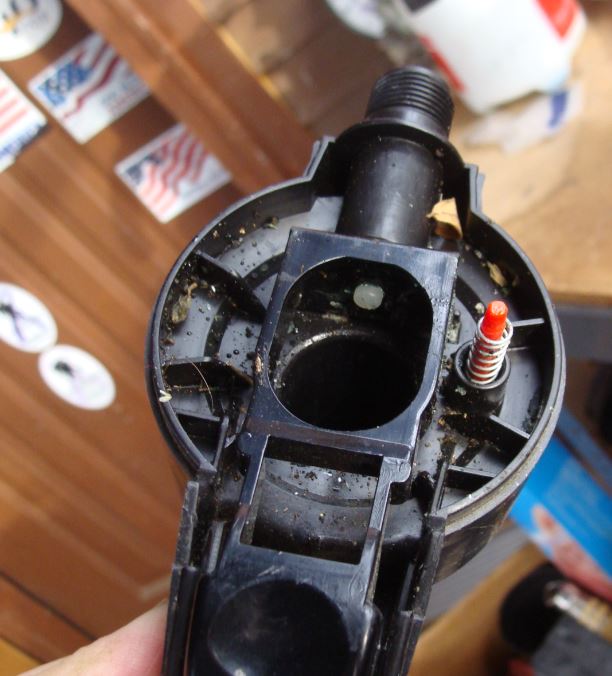
The pump head is NOT designed to keep dust and debris out. As soon as I opened the head and saw the leaf, it was obvious that debris had come in around the trigger and eventually made it down the well, keeping the seal from the edge of the cylinder. As soon as that happens, all your pressure bleeds out....
Sept 2021 Dirt "Fix" Failed
I tried using cotton balls to keep duff out of the interior. It works for a bit, but if the pump shaft gasket [#8] has worn, the mix gets past the O-ring, where it then soaks the cotton balls. When you push the trigger down, the soaked cotton balls are squeezed, and the mix runs down the back. Messy.
Birchmeier Super Star 1.25 Parts
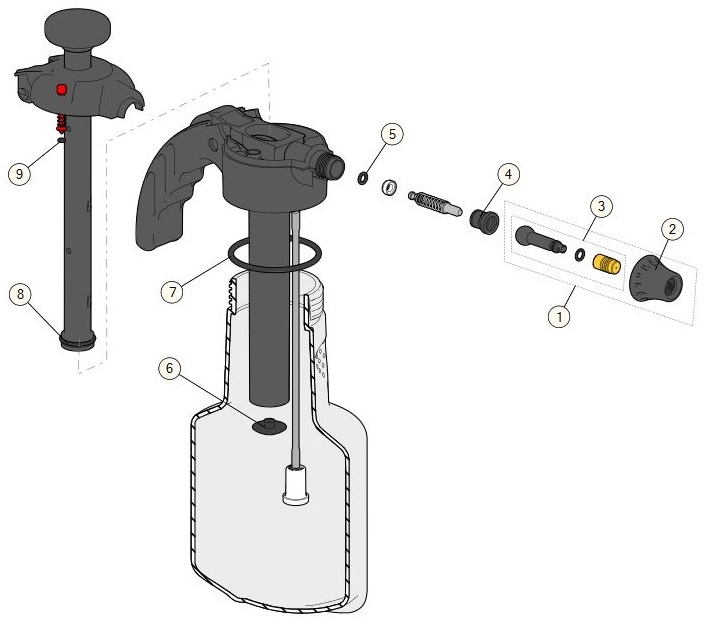
1. Brass nozzle, complete
2. Cap Screw PA [part of # 1]
3. Brass Nozzle
4. Retainer Ring PP EPDM
5. O-Ring 5 x 2 NBR
6. Pump Gasket NBR o24 mm
7. O-Ring 55.56 x 3.53 NBR
8. O-Ring 17.86 x 2.62 NBR
9. O-Ring 1.78 x 1.78 NBR
NOTE: It appears the 17.86mm x 2.62mm O-Rings are British Standard 1806 [#617] or the Italian UNI [OR123]. It is rated for dynamic applications [yay!]. The BS1806 is a tighter standard, while the replacement ISO 3601-1 is "looser", and lacks the specific size. YMMV.
Understand the size: 17.86mm x 2.62mm is an O-ring, 17.86mm ID, the ring thickness is 2.62mm, and a 23.1mm OD. Inch, .703 ID, ring thickness .103
After rinsing out the upper and lower halves, rinsing the O-Ring on the pump column [#8 17.86 x 2.62 NBR], the pump column goes up and down inside the pump cylinder smoothly.
Super Spray Internal Parts
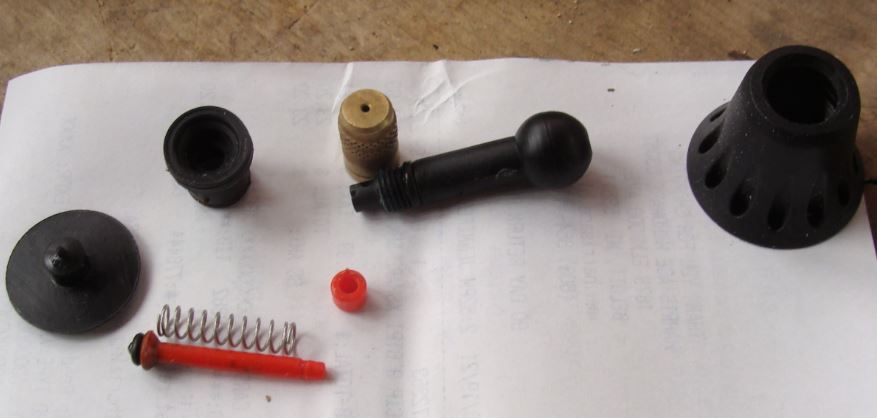
Once you have the upper and lower halves apart, there are few pieces that can be detached. Note the orange pressure relief stem has the teeny 1.78 x 1.78 NBR O-Ring attached. The orange cap snaps over a groove near one end.
Don't horse around with the brass nozzle in such a manner that you place heavy sideward pressure on it. During normal use, there are no concerns. But if for some reason you have the nozzle far out on the threads, the shaft might snap behind the threads.
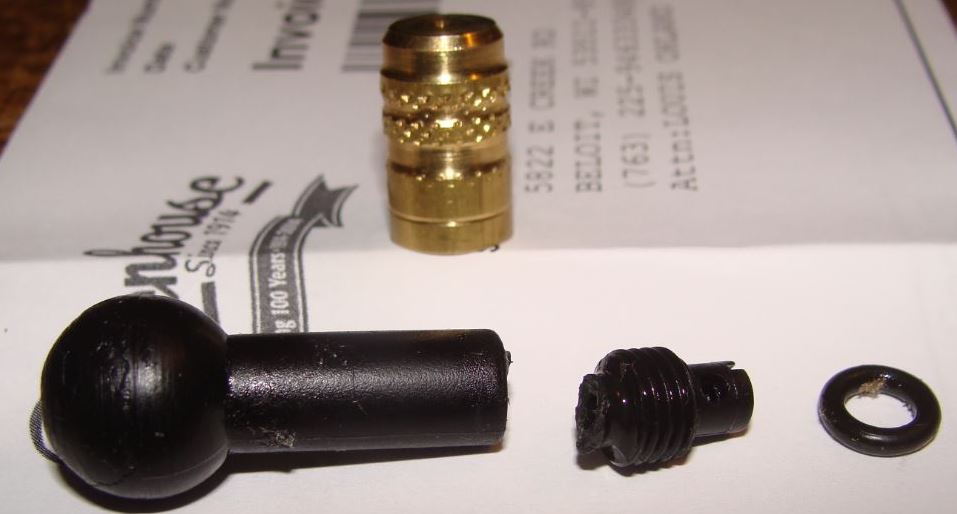
I have no idea on how this nozzle snapped. The seller, Rittenhouse, sent me a whole new Super Star because they couldn't get the replacement Nozzle Assembly... Outstanding customer support...
I scoured the net and found the replacement Nozzle Assembly through Agralan over in the UK. Adjustable nozzle brass complete SKU:11614805
WARNING! When re-assembling the brass nozzle onto the swivel, make sure it is actually threaded onto the shaft. The O-Ring will hold it pretty well all by itself, but you CAN loose the brass nozzle at some point... I know this for certain...
Debris on Pump Gasket Seat
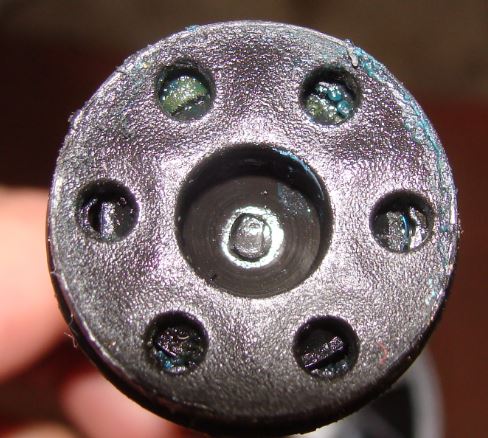
This is the main culprit when your Super Spray won't hold pressure. Notice the built up edge in the upper right quarter. This keeps the pump gasket from seating. Rub / wipe the built-up material from the seat.
Pump Gasket Side Profile
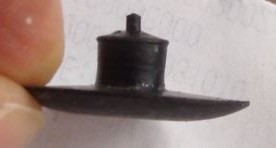
The O-Rings and the Pump Gasket are pretty beefy. Use a thin blade to get under the rim, and pry the stem up. I used a small pocketknife to gently tease the rim up, then I reversed the blade so the blunt side was to the inside. Do not tear this part up!
This part is in the Repair set Super Star 1.25 SKU:11614801 [from Agralan in the UK].
Once this gasket is out, rub / wipe the built-up material off the sealing surface.
Pump O-Ring
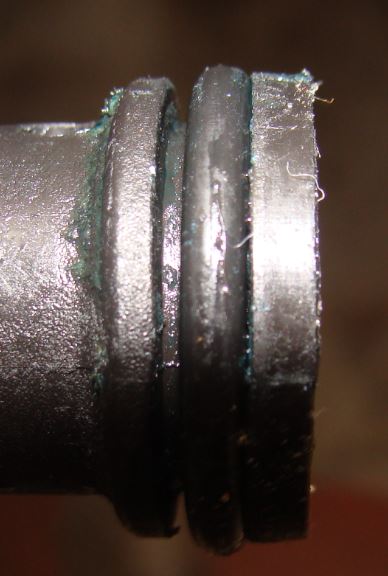
Although there are some debris, the O-Ring [17.86 x 2.62 NBR] does a good job sealing the pump shaft. To clean the Ring and the groove, "pinch" the O-Ring, squeezing it out towards one side. Then pull the slight loop towards the bottom in order to roll the O-Ring over the rim of the pump shaft. Re-installation is easy, spread it over the rim and roll it into place.
Pump Leaks At Rear
When the o-ring [#8] wears, the mix gets past it and sloshes around in the pump tube. The mix then runs out in whatever direction the head is tilted. Look for BS1806 #617 to replace the 17.86 x 2.62 O-ring.
Pressure Relief
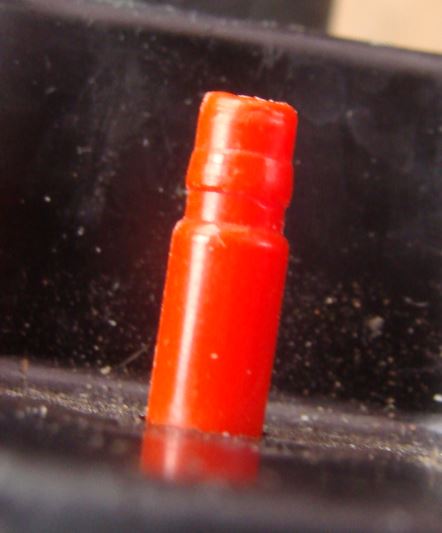
The red / orange little air pressure relief knob will come off if you pull firmly on it upwards. Removing it leaves the orange shaft, the spring, and the little 1.78 x 1.78 O-Ring in the orifice. If you leave the knob on, you must pull the upper half of the head straight up when removing it. I left the pressure relief in place when I cleaned my second Super Spray out.
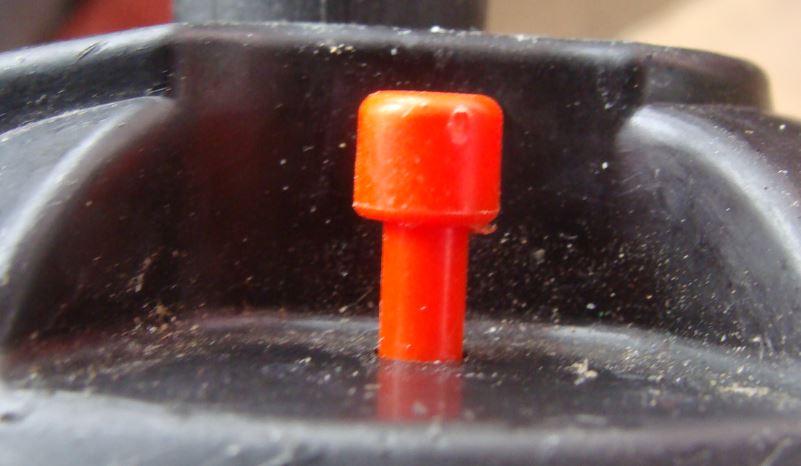
Pump Head Complete
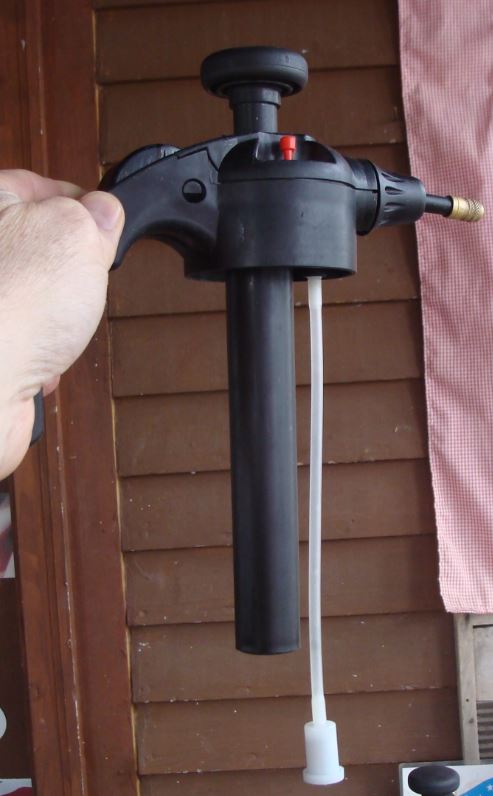
Ready to Mete out Justice
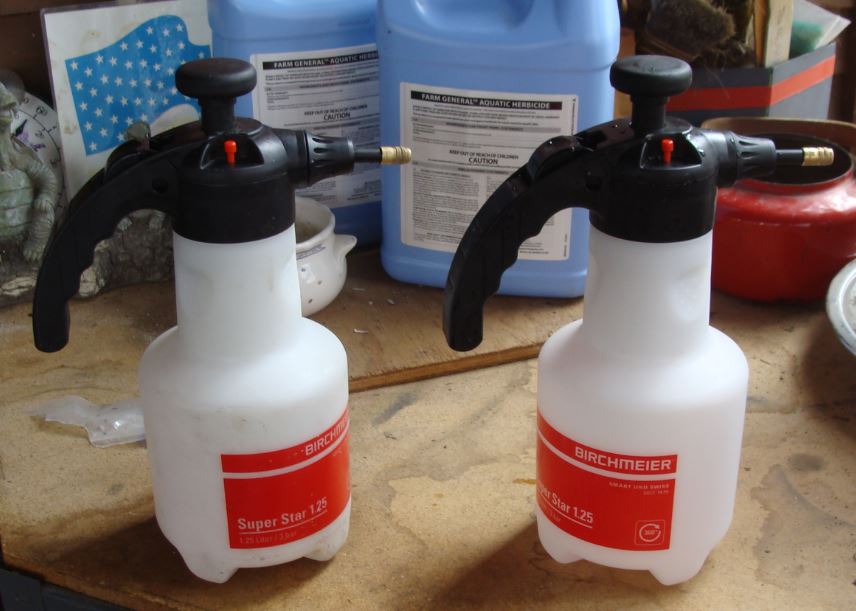
Brush Piles will happen
When you work alone, it is very apparent that being tidy is VERY slow. What finally happened with the bigger Honeysuckles is that you toss the cut branch with the small branches AWAY from you. So the largest end of the trunks point to you. The pile will be fairly compact [compared to just piling branches willy-nilly].
If you have the option, start cutting where you have an area for a slash pile. You can pile the slash out in the open, instead of stacking it up against the edge of the cut.
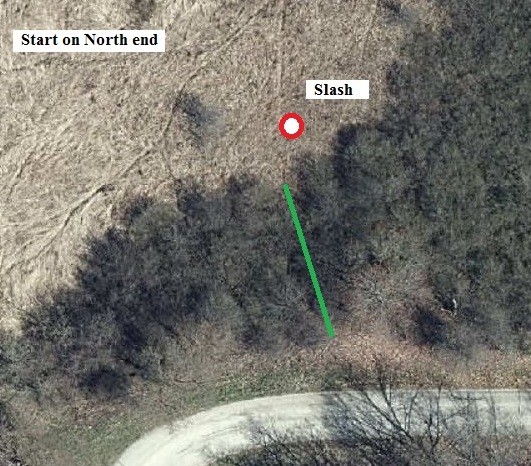
You can leave the branches where they lay. Then come back when it's cold and trim them up and pile them up. However, the slash may prevent / hinder Popple suckers from growing straight, and the slash also shades the soil.
Reduce Unneeded Movement
You are a lone human taking on the biological reserves of a planet. No matter what tools or chemicals you use, you are the -ONE- using them... Try to get tools that can be holstered without excessive movement. Holstered tools are on your person, not laying on the ground ten feet away... Sure, a backpack is nice, but if it is laying where you started, you will have to stop, get up, walk back, diddle around, then return.
Everything in Order
Running into a Honeysuckle patch, screaming the "Litany of Hate" and swinging cold steel is emotionally satisfying. But if the area is covered with leaves, that makes it easy to "loose" a small cut stump... which will happily resprout. Thanks to you cutting the rest of the bush away, this little sprout will have plenty of light... Eradicate one clump at a time, brush away any leaves or duff from around the stems, cut the stems, spray the stumps, make a brush pile, then move on.
What If You Miss One?
It happens. The overwhelming amount of effort in clearing a Honeysuckle patch is... clearing it. Now you should be able to move easily through the area and clip / paint any sprouts that emerge. Just to make everyone happy, I was cutting some Honeysuckle on 23 Dec 2019, the temperature was about 43 F, and there was a two inch high Honeysuckle sprout all leafed out...
Injurious Effects of Bush Honeysuckle:
Extended Season of Leaf Coverage
Leaf out early and drop late, shading native species out
Suppress Surrounding Plants
Produce compounds that inhibit plant growth
Provide Questionable Nesting Cover
Nests in branches are more exposed to predators
Fruits Have Lower Food Value
"abundant and rich in carbohydrates, do not offer migrating birds the high-fat, nutrient rich food sources needed for long flights, that are supplied by native plant species"
Increase Chance of Tick Borne Disease
If deer use Honeysuckle as cover, Ticks are prone to inhabit the plant
Growth Format Impedes Passage
Omni-directional spray of branches prevents easy passage, compared to the vertical growth form of Aspen or Alder.
Honeysuckle Control
Mechanical Control Alone
Low or no herbicide
Disturbs soil - surface is a good place for other invasive species
Effort intensive - one individual or one vehicle per Honeysuckle
Pull - no drift - no further effort (except burn or piles)
No issue with proximity to water (except erosion control as needed)
Herbicide Control Alone
Foilage spray - drift concerns, stems remain - further effort to cut
Cut and treat - no drift, stems are cut - no further effort (except burn or piles)
No soil disturbance - reduce ability of invasive species to start
Reduced effort - can be done with hand tools in remote areas
Water proximity - must use aquatic rated products
Reduce / Eliminate erosion - no disturbed soil as with Pulling
Cut And Paint
Cut and treat - no drift, stems are cut - no further effort (except burn or piles)
No soil disturbance - reduce ability of invasive species to start
Reduced effort - can be done with hand tools, -BUT- the bigger, the harder...
Water proximity - must use aquatic rated products
Reduce / Eliminate erosion - no disturbed soil as with Pulling
Reduced / Spot Application - apply to Cambium band only
Will work on stumps 1-2 foot tall
Herbicide Application Methods
Hand Pump - Dedicated or swapping. Reasonable size, weight.
Wick - Dedicated or swap. Wands / bottles. Less leakage.
Herbicide Application Guidelines (Cut)
Cut -ALL- stems
Spray / daub -ALL- stems, ensure coverage of outer layer (Cambrium)
Best time late fall - sprouting may occur, but sprouts will die -IF- stems properly treated
Return in late spring to see if touch-up required.
Herbicide Choice
20-25% mixture of glyphosate concentrate - can run higher, but more expensive
Aquatic rated products near water - glyphosate is low risk, but some additives are bad
Personal Protective Gear
Herbicide - (non spray) Impermeable gloves, eye protection, long sleeves, long pants.
Cutting Tools (Hand) - Same, except normal work gloves may be used while cutting.
Sources:
Control of Invasive Non-Native Plants [Web]
BUSH HONEYSUCKLES (Lonicera spp.), Belle, Amur, Morrow's, and Tatarian
honeysuckle... Bush honeysuckles create denser shade than native shrubs, reducing plant diversity and eliminating nest sites for many forest interior species. University of Missouri research found that Asiatic Bush Honeysuckle increases the risk of tick borne disease by a factor of ten.
Invasive shrubs increase spread of tick-borne disease [Web Only]
A review on the invasion ecology of Amur honeysuckle (Lonicera maackii, Caprifoliaceae) a case study of ecological impacts at multiple scales [Web]
Relationship Between Exotic Invasive Shrubs And American Woodcock [Web]
"If woodcock nesting locations are chosen in areas that are composed of a high percentage of invasive shrubs, the early leaf out and dense growth may prohibit detection of approaching predators."
SoilWeb [Web Based Application]
Pest Management – Invasive Plant Control Shrub Honeysuckles – Lonicera sp. [Web]
Suspend use of Herbicide for Buckthorn Treatment in Spring [Web Only]
Use of Herbicide in the Eradication of Honeysuckle (Wisconsin) [Web]
Lead Volunteer Application and Permit Form 1700-072 (R 8/15) (WI DNR)
Wildlife management volunteer opportunities [WI DNR - Web Only]
Response of avian communities to invasive bush honeysuckle (Lonicera spp.) [Web]
Invasive Lonicera fruits are low-quality fruits - low protein and lipid content
Rid Your Woods of Honeysuckle WIDNR (Youtube)
Wisconsin’s Forestland Woody Biomass Harvesting Guidelines
Field Manual for Loggers, Landowners, and Land Managers [Web]
Silviculture Handbook [Web]